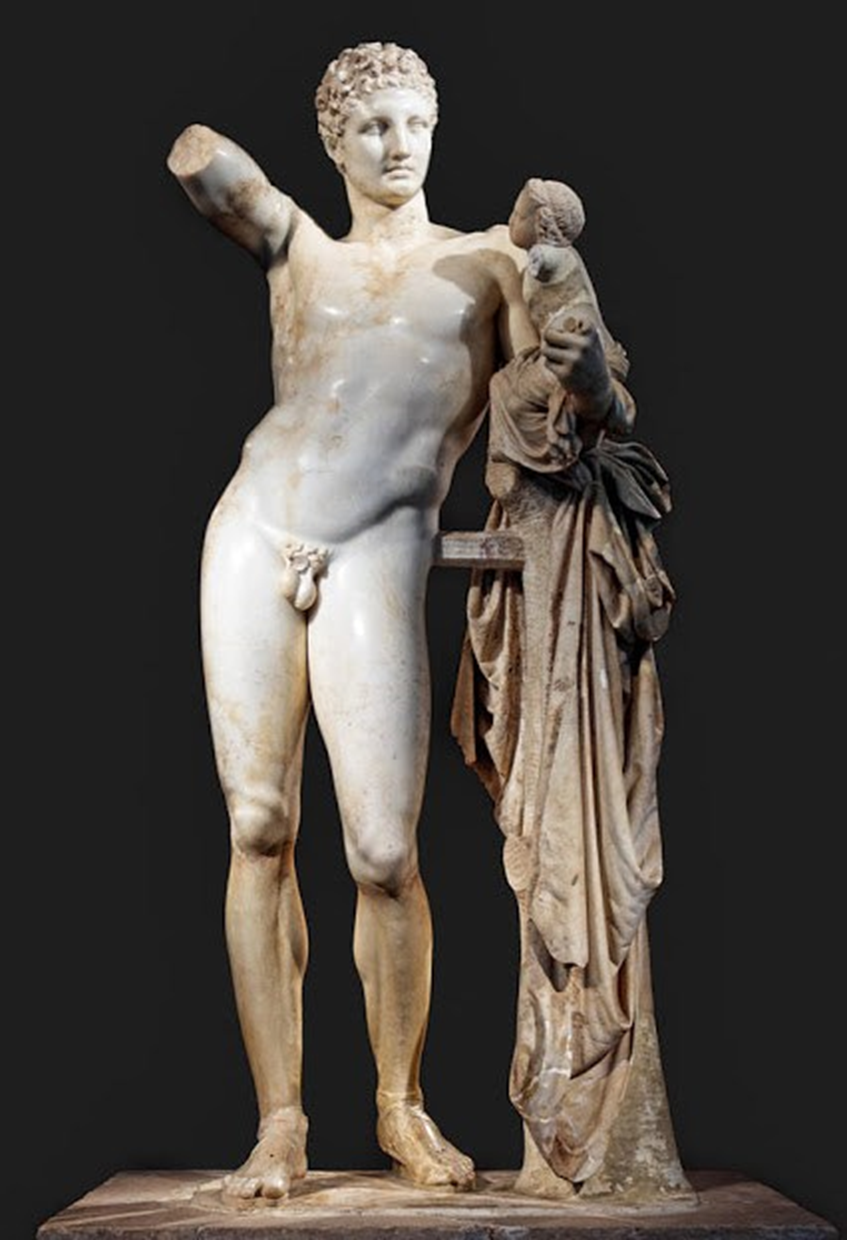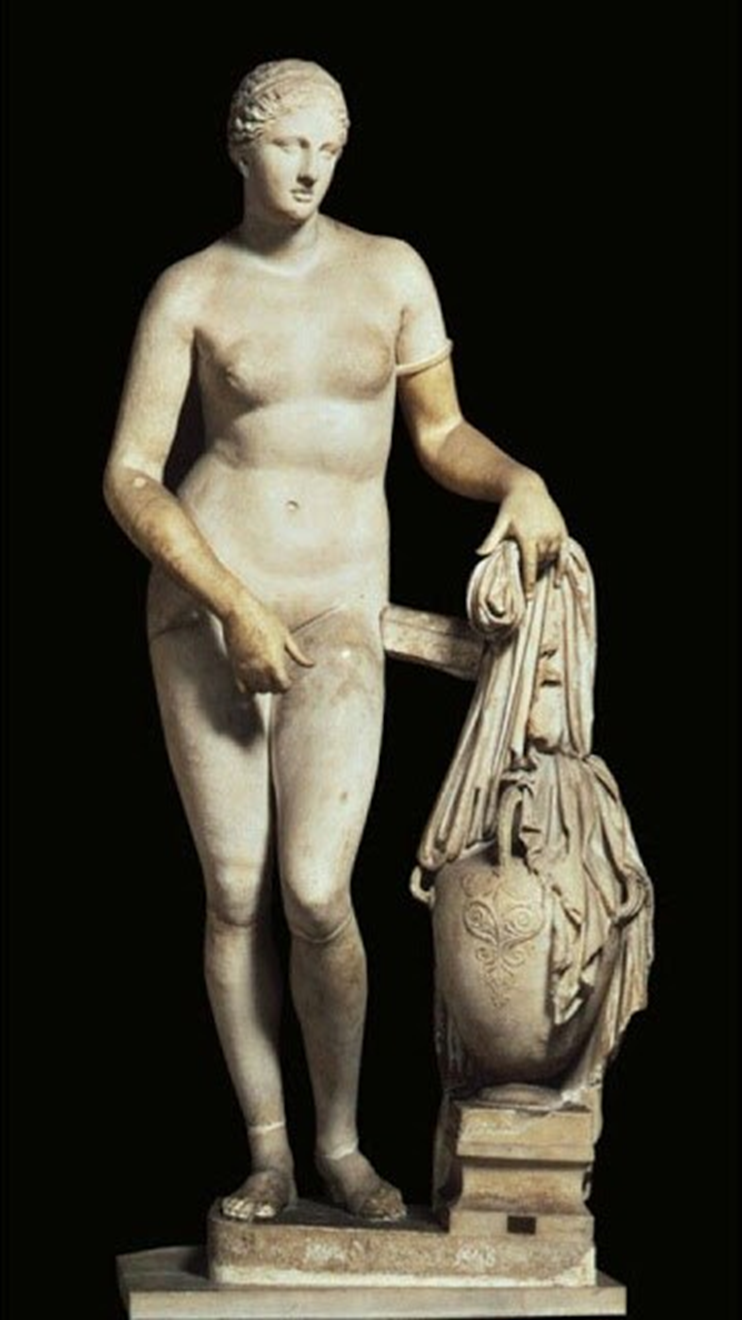In this analysis two ancient Greek sculptures from the same time period will be studied and described. The first sculpture is Hermes and the Infant Dionysus that is often considered to be made by Praxiteles in the 4th century BC; however, the assumption about its origin is not confirmed. It was found in Olympia and is currently displayed at the Archeological Museum of Olympia. It demonstrates Hermes holding the infant Dionysus in his left hand, with that he is leaning onto a tree branch that is wrapped in his cloak. The second sculpture is Aphrodite of Knidos, also made by Praxiteles from fine marble, although the original has been long lost. Today, numerous Roman copies of the authentic statue are exhibited in different museums and galleries. The sculpture depicts the ancient Greek goddess Aphrodite who is nude and is holding her cloak in her left hand over a jug.
Analysis of the sculpture Hermes and the infant Dionysus
Space and Setting
The statue of Hermes and the infant Dionysus will be subject to a visual analysis first. The initial standpoint from which both sculptures will be described is space and setting. Space created by the artist for this sculpture can be characterized as rather narrow, as it only includes the main participants of the scene in the perspective. Therefore, it can be said that the scene presented with the sculpture is shallow, not providing a distant view of it and the scenery behind the main figures.
Lines
The next aspect to be closely looked at is lines mostly present in the statue. Since the sculpture is attributed to Praxiteles, although his authorship is not confirmed, he is particularly known for a certain type of lines in his works. Thus, Hermes’s body demonstrates mostly curved lines which create a unique sense of balance that became so prominent in Praxiteles’s statues. These lines immediately attract the beholder’s attention upon looking at the sculpture, as they are particularly remarkable. Hermes’s standing body contributes to the lines being mostly vertical, including his sides, hips, and legs. As to the cloth in which the branch is draped, its wrinkles are mostly executed by means of straight vertical lines. The infant Dionysus’s body has a curve to it, similar to Hermes’s, as his back is slightly bent.
Composition
Composition of this sculpture presupposes a still scene, as Hermes is simply standing, leaning onto a wooden branch and holding the infant Dionysus on his arm. However, some movement may be implied within Hermes’s outstretched right hand that is currently missing. As to balance, as it has already been mentioned, Praxiteles’s works create a certain sense of balance, but it would be better put as the lack of balance. Hermes’s body is asymmetrically curving to the right in a contrapposto position. In contrast to it, the right side, consisting of the wooden branch and the infant Dionysus, is symmetrical, which creates a general off-balance appearance. For this reason, despite being perceived as a still scene, it does not create an image of something rigid but rather flowing and soft.
Figures and Iconography
Speaking about the figures presented in the sculpture, they seem static, as Hermes is holding the infant on his arm and Dionysus is sitting on his forearm. Hermes’s gaze is directed towards Dionysus, whereas the latter is looking at Hermes’s arm or the object he is holding in his hand. Therefore, the figures do not appear aloof but engaging, as their activities and reactions depend on each other. However, the beholder is not included in the scene and can only be considered a mere onlooker, as neither the gazes nor the motions of the figures are directed towards the viewer. As to the symbols, they are not exactly present in the current version of the sculpture; however, it is often assumed that Hermes was holding a branch of grapes in his missing arm. That might have been a reference to Dionysus’s fate to become the god of wine.
Medium
Moving on to the medium of the statue, it has already been established that Praxiteles mostly used fine marble in his works, and, although it is not proven that he, indeed, carved the sculpture, it is made of marble. The color is white, as is most common for marble, and its texture allows an artist to make a figure look more realistic since it is smooth and reminds human skin. Aside from that, marble is easy to polish, which allows it to last longer. On the other hand, as can be seen on the example of this sculpture, marble is susceptible to breaking, as a result of which Hermes’s arm is missing from the original scene.
Impressions
The overall impression created by the sculpture “Hermes and the Infant Dionysus” is that of a peaceful, still scenery. Although the beholder is not included in the events depicted by the statue, it is a welcoming view, overflown with the general effect of calmness, as the two figures are communicating with each other. Given the context of the situation, that is Hermes is taking the infant to the safety provided by mountain nymphs, the scene appears quite emotional.
Analysis of the sculpture Aphrodite of Knidos
Space and Setting
Moving on to the second sculpture, Aphrodite of Knidos, its analysis, again, should start with the description of space and setting. It is rather similar to the previous statue, as it exhibits one standing figure and a tall object nearby it. Here, however, there is no smaller figure and the distance between Aphrodite and the jug is bigger than between Hermes and the tree branch. Still, the artist presented the space of the overall scene as quite narrow, including only the goddess Aphrodite, her mantel, and the jug. Nothing in the statue indicates the perspective behind the figure, thus making it shallow.
Lines
The next aspect crucial for the analysis is the lines that are predominant in the given sculpture. Although this particular statue is a Roman copy of the lost original one, considering the fact that the authentic one was made by Praxiteles, the viewer can notice his famous curves. Since Aphrodite is standing upright, curved vertical lines are immediately discernible in such places as her hips, legs, and arms. Whereas her right arm is stretched out along her body covering her groin, her left arm makes the line more diagonal, as it is slightly bent, holding onto the cloak. Again, the wrinkled cloth of Aphrodite’s mantel is created by means of mostly straight vertical lines.
Composition
Speaking about the composition, the scene depicted in this sculpture is quite similar to the statue of Hermes and the infant Dionysus, although Aphrodite is the only human figure here. The goddess‘s body is in contrapposto, as she is standing upright but the weight is not distributed equally on both sides. Instead, she is leaning slightly onto the right side, while her left leg is relaxed and bent. The effect created is not that of a still scene but dynamic to a degree. It is implied that the goddess is reaching for the cloth, supposedly in order to cover her nude body. The overall impression does not make the beholder think that the scene is rigid; on the contrary, it appears soft and flowing due to Aphrodite’s smooth movement as she is taking her mantel.
Figures and Iconography
Further, the following subject of the analysis is the figures present in the sculpture. As it has been pointed out, Aphrodite does not appear static, but the dynamic aspect of her movement is elusive, as she has already reached out and is now holding onto the mantle. Aphrodite’s gaze is averted from the viewer to the left side, which makes the goddess appear rather aloof. Through this gesture Aphrodite does not engage the beholder in the scene with her and remains distant, concentrated on the cloth above the jug. As to the symbolism, the goddess’s nude body is an instance of the so-called heroic nudity, which is believed to be a means of demonstrating ideal figures of heroes and deities. However, before Praxiteles created his original Aphrodite of Knidos, heroic nudity had only been applied to male bodies, which made the sculpture so prominent.
Medium
Now, different copies of Aphrodite of Knidos were carved from different mediums, but this one, currently displayed at the Vatican Museum, was also made from marble. Like the previously described sculpture, this one is made of white marble which is quite popular but expensive. It can be noticed how the flow of time has impacted the medium, leaving some of the areas slightly yellow or even brown. However, although the medium can be easily damaged, this sculpture is well-preserved, as none of the goddess’s limbs are missing, and the entire composition is mostly intact, apart from some slightly chipped areas.
Impressions
The general impression created by this sculpture is that of a peaceful scene. It depicts a soft, calm occurrence as nude Aphrodite is stretching out her arm to cover herself with a mantel. The situation it exhibits is rather emotional, demonstrating the goddess as modest about her nudity, which was unusual and controversial at the time the statue was made, and this sentiment is reflected in the sculpture.
Appendix A

Appendix B

